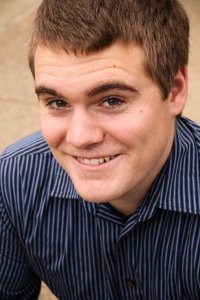Presented By: Aerospace Engineering
Defense Dissertation: Performance Characterization of a Low Power Magnetic Nozzle
Timothy Collard

Timothy Collard
Committee:
Dr. Alec Gallimore, Co-Chair
Dr. Benjamin Jorns, Co-Chair
Dr. John Foster, Cognate Member
Dr. Mark Kushner, Member
Dr. Justin Little, University of Washington, Member
The thrust and efficiency performance of low-power magnetic nozzles is analytically and experimentally investigated. The inherent advantages of these devices, including the electrodeless design and the potential to be propellant-agnostic, coupled with the potential to efficiently accelerate the propellant makes low-power magnetic nozzles attractive propulsion options for small satellites. A theoretical model was developed to predict low-power magnetic nozzle performance and identify fundamental differences in operation between these devices and their higher power counterparts.
An experiment was designed to inform the theoretical model to provide insight into the fundamental plasma dynamics within a low-power magnetic nozzle. This test article consisted of a reconfigurable inductively-coupled plasma source and an electromagnet. Electrostatic probes and laser induced fluorescence are used to measure the plasma properties throughout the plume. By coupling the experimental results with the theoretical framework two novel effects that reduce device performance are identified: $1$) neutral-collisional effects impedes ion acceleration and $2$) non-uniform power deposition degrades source and divergence efficiency. These effects arise from the low input power and the thruster design parameters. Experimental characterization of a reconfigured test article demonstrates that performance can be recovered by accounting for these two effects when designing the thruster and selecting the operating parameters.
Committee:
Dr. Alec Gallimore, Co-Chair
Dr. Benjamin Jorns, Co-Chair
Dr. John Foster, Cognate Member
Dr. Mark Kushner, Member
Dr. Justin Little, University of Washington, Member
The thrust and efficiency performance of low-power magnetic nozzles is analytically and experimentally investigated. The inherent advantages of these devices, including the electrodeless design and the potential to be propellant-agnostic, coupled with the potential to efficiently accelerate the propellant makes low-power magnetic nozzles attractive propulsion options for small satellites. A theoretical model was developed to predict low-power magnetic nozzle performance and identify fundamental differences in operation between these devices and their higher power counterparts.
An experiment was designed to inform the theoretical model to provide insight into the fundamental plasma dynamics within a low-power magnetic nozzle. This test article consisted of a reconfigurable inductively-coupled plasma source and an electromagnet. Electrostatic probes and laser induced fluorescence are used to measure the plasma properties throughout the plume. By coupling the experimental results with the theoretical framework two novel effects that reduce device performance are identified: $1$) neutral-collisional effects impedes ion acceleration and $2$) non-uniform power deposition degrades source and divergence efficiency. These effects arise from the low input power and the thruster design parameters. Experimental characterization of a reconfigured test article demonstrates that performance can be recovered by accounting for these two effects when designing the thruster and selecting the operating parameters.